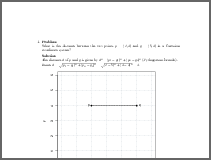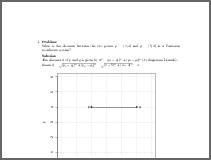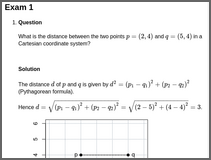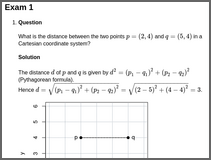dist: Distances and the Pythagorean Theorem
distWhat is the distance between the two points \(p = (2, 4)\) and \(q = (5, 4)\) in a Cartesian coordinate system?
The distance \(d\) of \(p\) and \(q\) is given by \(d^2 = (p_1 - q_1)^2 + (p_2 - q_2)^2\) (Pythagorean formula).
Hence \(d = \sqrt{(p_1 - q_1)^2 + (p_2 - q_2)^2} = \sqrt{(2 - 5)^2 + (4 - 4)^2} = 3\).
What is the distance between the two points \(p = (3, 2)\) and \(q = (5, 5)\) in a Cartesian coordinate system?
The distance \(d\) of \(p\) and \(q\) is given by \(d^2 = (p_1 - q_1)^2 + (p_2 - q_2)^2\) (Pythagorean formula).
Hence \(d = \sqrt{(p_1 - q_1)^2 + (p_2 - q_2)^2} = \sqrt{(3 - 5)^2 + (2 - 5)^2} = 3.606\).
What is the distance between the two points \(p = (3, 2)\) and \(q = (4, 1)\) in a Cartesian coordinate system?
The distance \(d\) of \(p\) and \(q\) is given by \(d^2 = (p_1 - q_1)^2 + (p_2 - q_2)^2\) (Pythagorean formula).
Hence \(d = \sqrt{(p_1 - q_1)^2 + (p_2 - q_2)^2} = \sqrt{(3 - 4)^2 + (2 - 1)^2} = 1.414\).
(Note that the HTML output contains mathematical equations in MathML, rendered by MathJax using ‘mathjax = TRUE’. Instead it is also possible to use ‘converter = “pandoc-mathjax”’ so that LaTeX equations are rendered by MathJax directly.)
Demo code:
library("exams")
set.seed(403)
exams2html("dist.Rmd", mathjax = TRUE)
set.seed(403)
exams2pdf("dist.Rmd")
set.seed(403)
exams2html("dist.Rnw", mathjax = TRUE)
set.seed(403)
exams2pdf("dist.Rnw")


